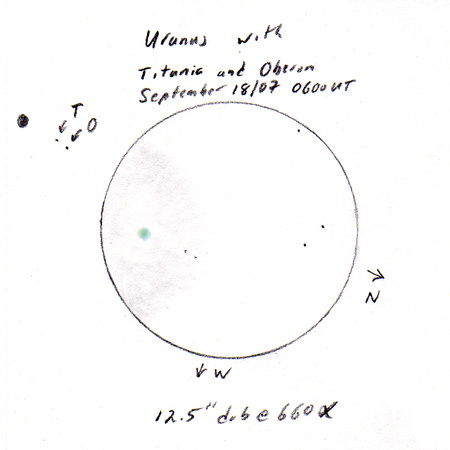On September 12th Alan Whitman put forth the challenge as to whether a moderate sized telescope would be able to see any of the Moons of Uranus. Seeing as he deemed a12.5” scope moderate in size a little voice in my head said, “sign me up”. Here is my tale.The night of Monday September 17th was so much fun. With Sunday having done nothing but rain and it looking like grey autumn had begun, the CSC for Monday showed promise of clears skies and that promise came through. Looking at the S&T applet for Uranus’ moons placement, it also gave the thumbs up.
http://www.skyandtelescope.com/observing/objects/planets/3310476.html# inally after looking at the position of the jet stream, I could see that all of my little duckies were in a row. A few days earlier on the 13th, similar conditions prevailed but moisture in the air made the light scatter intolerable. The amount of glare around all bright objects forced me to pack up and head home early. Early in the evening, after driving kids to and from various activities I drove my 12.5” dob the few km down the road from my home to the Newton-Godin observatory, at Pearson College. It was actually a good night to go out there because it was the first night of the astronomy activity for the students. I set up my scope and left it there to cool and returned to driving around doing kid duty. By the time I had returned to the observatory around 2100hrs, it was dark enough to give the students the standard introductory constellation tour around the sky and to show them some introductory telescopic objects through my ED 80mm refractor and 12.5” truss dob. By around 2200hrs the time had come for me to settle into my quest. Uranus by then had become a faint naked eye object. To all who wanted, I show views of both Uranus and Neptune through my dob at 317X. I also showed them how they looked at around 100X through the little refractor to give them an idea of how small these planets actually appear.As I increased power step by step up to 390X using a 10mm eyepiece in a 2.5X Powermate I grew discouraged, as I could see nothing appearing in the glow of the planet. Finally I dropped my 9mm ploessl into the Powermate and with 440X, and averted vision, two faint dots close together appeared out of the mist in the correct orientation. Putting a 6mm Radian into the Powermate for 660X improved the situation even more. I was then able to hold the two dots with a steady direct gaze. My biggest problem was keeping those dots within the FOV. Luckily I was using a well-crafted scope and the movement was very smooth. The attached sketch represents my view at 660X. The grey cloud that I’ve drawn around the green orb of Uranus represents the glow of the planet. Moisture in the air made this observation rather difficult. I was quite surprised at how drained I was when I finished. The Sky and Telescope article mentions how these two moons have been glimpsed with as small aperture as 8 inches. I can only imagine their observing conditions were far better than what I was presented with.I just want to thank Alan for stimulating me into making this very worth while observation.Bill


